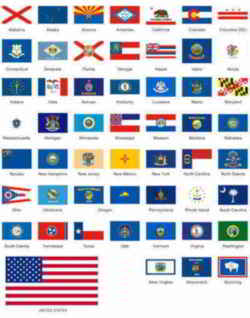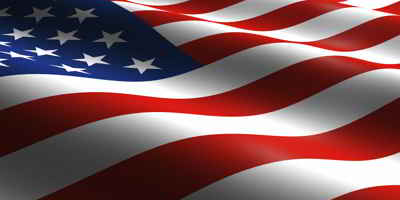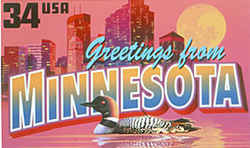Minnesota State Flag
Adopted in 1893; 1957.
The flag of the state of Minnesota consists of a medium blue field charged with the state seal. The current flag was adopted in 1957 and the state seal on the flag was modified in 1983.
The Minnesota flag has come under increasing criticism both for its poor design and its image in the seal of a farmer watching a Native American in the background, symbolizing Manifest Destiny and the inevitability of land being procured by white settlers
The Minnesota State Flag
The first state flag was designated in 1893. (Laws of Minnesota 1893, Chapter 16.) A prototype flag was commissioned from the local embroiderer Pauline Gerhardin Fjelde, which won a gold medal at the Chicago World's Fair.
The 1893 flag, designed by the Amelia Hyde Center of Minneapolis, was white on one side and light blue on the other. In the center was the state seal wreathed with white moccasin flowers, on a blue field. A red ribbon in the seal bore a motto, L'étoile du nord (French for "The North Star"). The years 1819 (establishment of Fort Snelling), 1858 (statehood) and 1893 (adoption of the first state flag) appeared in gold around the state seal. "Minnesota" was written under the state seal in gold and 19 gold stars arranged in clusters to form the points of a star, representing the fact that Minnesota was the 19th state added after the original 13 states. 87 circles around the seal represent Minnesota's 87 counties.
The flag was redesigned and adopted in 1957 (Laws of Minnesota 1957, Chapter 155, Sections 1-4), based on a proposed design by a legislative interim commission created in 1955 eliminating the different-colored sides in favor of a blue field on both sides. This made the flag less expensive to manufacture and also more durable in high winds. This opportunity was used to correct an error of the flowers used on the seal; instead of a Pink and White Lady's Slipper, the 1893 flag showed a variant that was not native to the state.
(Laws of Minnesota 1955, Chapter 632) Minnesota Statutes 1.141 describes the flag and conditions under which it should be flown. In 1989, a new flag design was proposed by the Minnesota Flag Coalition, but no bill was introduced. In 2000, Sen. Ed Oliver introduced a bill (SF3587) proposing a legislative task force on the design of the state flag, but the bill did not pass.
The Minnesota state flag is royal blue, with a gold fringe. In the center of the flag is the state seal. Around the state seal is a wreath of the state flower, the lady slipper. Three dates are woven into the wreath: 1858, the year Minnesota became a state; 1819, the year Fort Snelling was established; and 1893, the year the official flag was adopted. Nineteen stars ring the wreath. The largest star represents Minnesota.
Minnesota Flag Law
Minnesota Statutes, Chapter 1.
Minnesota Statutes, Chapter 1.
Jurisdiction, Civil Divisions.
CHAPTER 1. Sovereignty, Jurisdiction, Emergency Operation, General Policies.
SECTION 1.1441.
1.141 Official state flag.
Subdivision 1. Adoption. The design of the state flag proposed by the legislative interim commission acting under Laws 1955, Chapter 632, is adopted
as the official state flag.
Subd. 2. Photograph. The secretary of state shall file a photograph of the state flag. The secretary shall also retain custodial control over the sample
design flag of the commission for use by the public for copies.
Subd. 3. Description. The design of the flag shall conform substantially to the following description: The staff is surmounted by a bronze eagle with
outspread wings; the flag is rectangular in shape and is on a medium blue background with a narrow gold border and a golden fringe. A circular emblem
is contained in the center of the blue field. The circular emblem is on a general white background with a yellow border. The word MINNESOTA is inscribed
in red lettering on the lower part of the white field. The white emblem background surrounding a center design contains 19 five pointed stars arranged
symmetrically in four groups of four stars each and one group of three stars. The latter group is in the upper part of the center circular white emblem.
The group of stars at the top in the white emblem consists of three stars of which the uppermost star is the largest and represents the north star.
A center design is contained on the white emblem and is made up of the scenes from the great seal of the state of Minnesota, surrounded by a border
of intertwining Cypripedium reginae, the state flower, on a blue field of the same color as the general flag background. The flower border design contains
the figures 1819, 1858, 1893.
The coloring is the same on both sides of the flag, but the lettering and the figures appear reversed on one side.
Subd. 4. Official flag. The flag described above is the official flag of the state of Minnesota.
Subd. 5. Hours of flying. The official state flag shall be flown on the state capitol grounds at all times between sunrise and sunset.
HIST: 1957 c 155 s 1-4; 1959 c 371 s 1; 1984 c 628 art 1 s 1; 1986 c 444
Copyright 2002 by the Office of Revisor of Statutes, State of Minnesota.
Statutory citation: Minn. Stat. 1.141
History:
1893 Minn. Laws Chap. 16 (SF545) - Appoints the commission to adopt a design; gives general guidelines for the design.
1955 Minn. Laws Chap. 632 (HF1601) - Creates interim committee to study and consider change.
1957 Minn. Laws Chap. 155 Sec. 1-4 (SF887) - New revised design specified.
1959 Minn. Laws Chap. 371 Sec. 1 (SF605) - Relates to flying the flag.
In 1989 William Becker and Lee Herold of Rochester proposed a new flag design, but no bill was introduced.
Sources of additional information:
Joseph A.A. Burnquist, ed. Minnesota and Its People. Chicago: S.J. Clarke Publishing, 1924. Vol. 1, p. 327-328.
Report of the Interim Committee on Change of the State Flag, 1955. Interim committee authorized by 1955 Minn. Laws Chap. 632 (HF1601).
William M. Becker, "The Origin of the Minnesota State Flag," Minnesota History 53:1 (Spring 1992): 2-8.

The Flags of the US.







